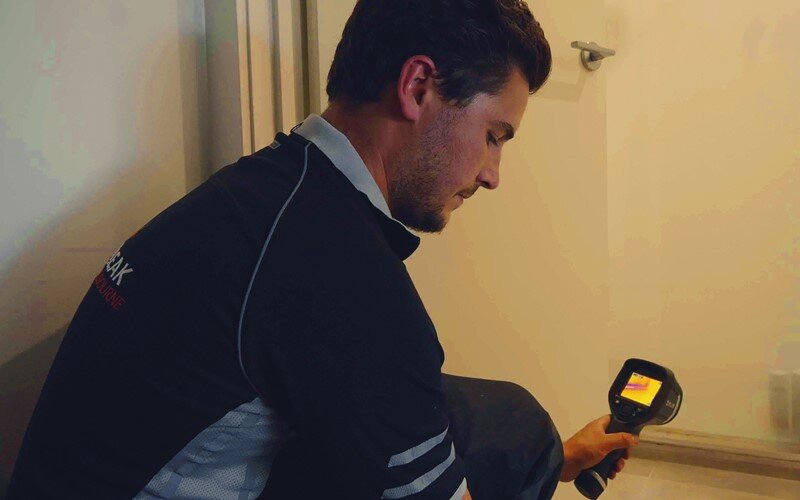Were you on the lookout for suggestions about Top leak detection hacks?

Early discovery of leaking water lines can minimize a prospective catastrophe. Some small water leakages might not be visible.
1. Take A Look At the Water Meter
Every home has a water meter. Checking it is a guaranteed way that aids you discover leakages. For beginners, turn off all the water sources. Guarantee nobody will certainly flush, use the faucet, shower, run the washing maker or dish washer. From there, go to the meter and also watch if it will alter. Because no one is using it, there must be no motions. That shows a fast-moving leak if it moves. Furthermore, if you find no changes, wait a hr or two as well as inspect back once more. This indicates you might have a slow leak that might even be below ground.
2. Inspect Water Consumption
If you identify abrupt modifications, despite your usage being the very same, it indicates that you have leaks in your plumbing system. An unexpected spike in your expense indicates a fast-moving leakage.
A constant boost every month, also with the very same habits, reveals you have a slow-moving leak that's additionally slowly escalating. Call a plumber to completely check your residential or commercial property, specifically if you feel a warm location on your flooring with piping underneath.
3. Do a Food Coloring Test
When it involves water usage, 30% originates from bathrooms. Test to see if they are running correctly. Decrease flecks of food color in the container as well as wait 10 mins. There's a leak between the tank as well as bowl if the shade in some way infiltrates your bowl throughout that time without flushing.
4. Asses Outside Lines
Do not fail to remember to inspect your exterior water lines also. Needs to water permeate out of the link, you have a loosened rubber gasket. One tiny leak can throw away loads of water and spike your water costs.
5. Check and Evaluate the Circumstance
Homeowners ought to make it a practice to inspect under the sink counters as well as even inside cabinets for any bad odor or mold growth. These two red flags suggest a leakage so timely interest is needed. Doing routine assessments, even bi-annually, can save you from a major trouble.
Inspect for discolorations and deteriorating as many pipelines as well as appliances have a life expectations. If you think dripping water lines in your plumbing system, don't wait for it to rise.
Early detection of dripping water lines can mitigate a prospective disaster. Some small water leakages may not be noticeable. Checking it is a guaranteed way that helps you find leakages. One small leakage can waste heaps of water and surge your water costs.
If you think dripping water lines in your plumbing system, do not wait for it to intensify.
How to Know If Your Home Has a Hidden Leak
Water Meter Reveals Inexplicable Water Usage
If you’d like to test whether or not there’s a leak somewhere in your home, you can do this using your water meter. Here is how to conduct the test:
Don’t use any water in your home for at least 30 minutes; this also means not turning on faucets or water-using appliances.
Go outside, and check your water meter for activity.
If your water meter shows that there was activity, even though no one was using any water, this proves that there is a leak in your home.
Visible Mold or Mildew Growth
Leaks behind walls create moist, dark environments that allow mold and mildew to grow and thrive. Eventually, you might see mold growth forming on the wall closest to a hidden leak.
If mold is growing in an area that receives a high amount of moisture, such as a bathroom, it may simply be an indication that better ventilation is needed. However, if you see mold growth on a wall or the ceiling in an area where you would not expect, you probably have a hidden leak.
Musty, Mildew Odor
Sometimes you might not be able to see the mold or mildew that is growing as a result of a leak. However, the smell can give the problem away just as easily. If you catch a whiff of something musty, there’s a good chance that old water is collecting somewhere in your home that you can’t see.
Stained/Warped Walls, Ceilings, or Floors
When your home soaks up water, a variety of red flags can become visible, including ceiling stains, bubbling drywall, warped walls, and sagging floors. While these issues can be caused by excess humidity, they can also be signs that a pipe or plumbing connection has started leaking behind your walls.
Inexplicably High Water Bill
After a while, you get a general sense for what your water bill should be. If you own a pool or sprinkler system, your bill will tend to be higher during summer. However, if you receive a water bill that seems especially high, and you can’t figure out what caused it, then you may have a hidden leak somewhere that’s increasing your bill.
https://www.plumbingjoint.com/blog/2019/july/how-to-know-if-your-home-has-a-hidden-leak/

As a keen person who reads on Hacks to detect leaks, I think sharing that information was really helpful. Do you know anybody else who is involved in Finding hidden leaks? Why not share it. We cherish reading our article about Finding hidden leaks.
 Val Kilmer Then & Now!
Val Kilmer Then & Now! Ashley Johnson Then & Now!
Ashley Johnson Then & Now! Soleil Moon Frye Then & Now!
Soleil Moon Frye Then & Now! Jeri Ryan Then & Now!
Jeri Ryan Then & Now! Terry Farrell Then & Now!
Terry Farrell Then & Now!